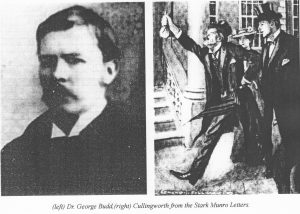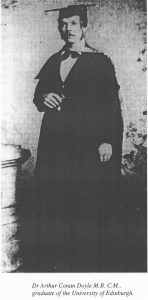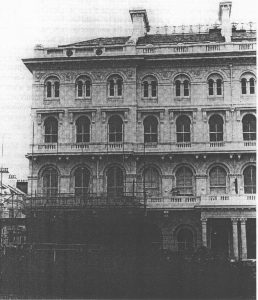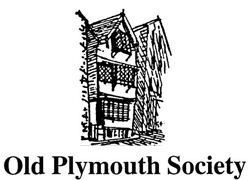by Len Stephens
Published May 2012
Mystery and distortion have surrounded Sir Arthur Conan Doyle’s early stay and life in Plymouth. It has been alleged that he lived here for two years in a house at No. 1 Durnford Street, Stonehouse where he also practised medicine. There is a commemorative plaque stating this on the walls of Renwick’s car showrooms, the site of Dr. Budd’s surgery where Doyle was his assistant for only two months. The PDC Waterfront News in 1994 and more recently Plymouth’s Waterfront Walkway publication have romantically described Conan Doyle’s early life at Durnford Street with the implication that the story of Sherlock Holmes and The Hound of the Baskervilles was closely connected with his stay there. So perhaps it is about time the connection was unravelled.
As a Sherlock Holmes’ enthusiast I thought I would try to uncover by deduction the truth about Holmes’ creator Conan Doyle and his connection with Plymouth and the Westcountry. I rely for my facts firstly on Conan Doyle’s autobiographical story “The Stark Munro Letters” published in 1907 as a Daily Mail sixpenny novel. Secondly on reading biographies of Conan Doyle by Hesketh Pearson (published 1943) and Martin Booth (published 1997). The Stark Munro Letters is the definitive study of young Conan Doyle from March 1881 to November 1884 and area series of letters written by a young doctor Stark Munro to his American friend Herbert Swanborough about his life in Bradfield and Birchespool which was in actual fact Doyle’s life in Plymouth and Southsea, Portsmouth.
Arthur Conan Doyle was 23 when he came to Plymouth in 1882 and according to his biographies had up to then a colourful career. He had been brought up a Catholic, educated at Edinburgh where he obtained his degree in medicine and surgery and he came under the influence of Dr. Joseph Bell and fellow student George Budd (both of whom inspired characters in his later stories). He started his medical career as a ship’s doctor, first on an Arctic whaler, the Hope, then on a West African cargo ship, the Mayumba where he began writing short stories and photographic essays. Illness prevented his continuing on the Mayumba and he went to live with his uncles in London in early 1882. For various reasons he became unsettled, renouncing his faith, and in April 1882 received a telegram from Dr. Budd which was to have a profound effect on his future career

Dr. George Turnavine Budd was quite a remarkable man – the description of him, alias Cullingworth at the beginning of the Stark Munro Letters is most colourful, but it was the inner man that captivated Conan Doyle who described him as “the greatest genius that I have ever known”. After leaving Edinburgh University Doyle and Budd had gone their separate ways and although they had made contact with each other whilst Budd was practising at Bristol they did not meet up until May 1882. It arose from a cable that Doyle received in April 1882 from Budd that said “Started here in Plymouth last June. Colossal success. My example must revolutionise medical practice. Rapidly making fortune. Have invention which is worth millions. Unless our Admiralty take it up shall make Brazil the leading naval power. Come down on next train on receiving this. Have plenty for you to do.” After a further telegram ten days later guaranteeing him £300 the first year Doyle left for Plymouth thinking he was on the threshold of a fortune. He was met by Budd on the railway platform and a luxurious carriage drawn by two fine looking black horses took them off to Budd’s residential house on the Hoe – 6 Elliot Terrace.
Doyle described it as a spacious hotel (it had been a leading club the rent being too high for its members) with an imposing sweep of steps up to the door above which were five or six storeys with pinnacles and flagstaff on the top. There were thirty odd rooms, not all furnished but the ground floor rooms and hall were on a spectacular scale. Welcoming Doyle to his “little place” Budd took him to a top bedroom, which was to be Doyle’s. The room contained a small iron bed and a basin mounted on a packing case. Budd stating “there’s no good my putting a £40 suite into a bedroom and then having to chuck it out in order to make room for a £100 one”. After dinner washed down with champagne Budd took Doyle into a backroom to show him his latest project as his scientific interests went beyond medicine. His invention was a means of increasing the strength of an electromagnet to such an extent that it would deflect cannon balls, which he claimed would bring “naval supremacy and command of the seas”. The following day Doyle was taken to Budd’s surgery at No. 1 Durnford Street, Stonehouse which he described as a whitewashed building in a large square. Here patients waited on the staircase and in the coach house as well as in the waiting room. On his arrival Dr. Budd asked the pageboy “How many here?” and received the reply “One hundred and forty, sir”. This confirmed his estimate to Doyle that he had treated 30,000 patients in the past year, but how did he arrive at his earnings of more than £4,000?

The treatment was free but the patients had to pay for their prescriptions that were dispensed on the premises by Mrs. Budd. The takings for that day were £32 8s 6d which he carried home at the end of the day. According to Doyle he doled out medicine in a “heroic and indiscriminate manner”, sometimes for no other reason than to earn a fee. Budd invented his own wonder cures, one was Dr. Budd’s Blood Tonic advertised a bottle of 20 doses for sale at 3s 6d in the British Medical Journal and Western Morning News, where it was claimed it renovated the blood, cleaning it of impurities. Budd was not above prescribing heavy doses of drugs like cocaine and opium, both of which regularly appeared in Conan Doyle’s stories of Sherlock Holmes, who was himself addicted.
However, Doyle gradually felt uneasy over Budd’s medical ethics that led to their falling out and Doyle leaving the practice after only eight weeks. Budd offered Doyle a pound a week to help him start up his own practice and Tavistock was considered – so he went there to see if there was a shortage of doctors. It is named Stockwell in the Stark Munro Letters and is described as a “picturesque little English town with a history and little else”; where there appeared to be more doctors than patients. So Conan Doyle decided to go to Portsmouth instead to start up a practice. At the end of June 1882 he boarded an Irish steamer and alighted at the Clarence Pier, Southsea.
During his short stay in Plymouth Doyle had been encouraged by Budd to write novels to supplement his income. However he would have had little time to write stories during his two months in Plymouth. His little recreation was confined to playing billiards with Budd and visiting Dartmoor since he was a keen photographer. He travelled out by train to Yelverton and Princetown where he walked the moors with his camera. He produced a Photographic essay on Dartmoor which he published in 1882 (according to Martin Booth) but I have been unable to get a copy of this publication. It is possible that it is included in Conan Doyle’s Essays on Photography by John Michael Gibson and Richard Green, but there isn’t a copy in Plymouth’s Library. It is a matter of conjecture whether his trips to Dartmoor and Tavistock provided him with any background for the two stories of the Westcountry – “The Hound of the Baskervilles” (1901), or “The Adventure of Silver Blade” (1892). Although the story of a missing racehorse and the death of its trainer is a good Sherlock Holmes’s story, Doyle’s research of the Tavistock area should have told him that placing a horse racing stable at Kings Pyland on Dartmoor was most unsuitable for racehorse rearing.

Although he had fallen out with Budd, in his last 3 weeks in Plymouth Doyle stayed to take care of a sick Dr. Budd and his practice in Durnford Street, for which he was paid £40. When Doyle set up practice in Southsea he had little money other than this payment and the pound a week promised to him by Budd until the practice had been built up. Unfortunately this ceased when Budd wrote accusing him of treachery saying that he had found an incriminating letter from Doyle’s mother in which it appeared that Doyle had libelled him. Doyle was now left to find a supplementary source of income and this was to begin his literary career, although at first as a part time occupation. He had written some stories between 1878 and 1882 under a pseudonym and a few had been accepted by the editors of magazines that appealed to boys. Normally he received a fee of three to four guineas but in 1883 writing for the Cornhill magazine he was paid 29 guineas for his tale “Habakuk Jephson’s Statement” and from then on his stories became more profitable although it was not until 1887 that he created his first Sherlock Holmes story “A Study in Scarlet”.
For this he received an advance of £25 from the published Ward Lock & Co. (it first appeared in Beeton’s Xmas Annual 1887). Whilst awaiting its publication Doyle decided to establish himself as a serious historical novelist with his first novel “Micah Clarke” the narrative of an old man about his adventures as a youth during the 1685 Monmouth Rebellion with its climax in the Westcountry at the Battle of Sedgemoor. Doyle gave up his practice in Southsea at the end of 1890 and left Portsmouth to go to Vienna. On his return he went to live in London where he embarked on a full-time literary career. He had loved living in Portsmouth as is evident in his autobiography and the Stark Munro Letters. He spent eight happy years there building up a grand social reputation he was involved with the local Literary and Scientific Society and Liberal Unionist Party. He was also a great sportsman, a founder member of Portsmouth Football Club, he played for the Portsmouth Cricket Club (later he captained an MCC team) and he was an excellent billiards player.
So where do Plymouth and Devon play their part in Conan Doyle’s literary career and should the city play up the importance of his short stay in Plymouth? There is no doubt that his experiences with Dr. Budd had a great influence on him giving up a medical career for writing. Also, Budd’s erratic behaviour bordering on a state of genius is used in many characters in his stories. It has been said that Sherlock Holmes was based on a combination of Dr. Budd and Dr. Joseph Bell (his mentor at Edinburgh). In the opening chapters of “A Study in Scarlet” introducing us to Sherlock Holmes we can see in the consulting detective the exuberance and eccentricities of Dr. Budd with his scientific experiments combined with the science of deduction and analysis of Dr. Bell. In his biography of Doyle, Hesketh Pearson writes “it is Budd, far more than any original, who gives life to the professors in his stories, many of which owe their inspiration to the same source. Budd is in the energy of Holmes, the braggadocio of Gerard, the malignity of Moriarty, the violence of Roylott, the fanaticism of Maracot, and the more extravagant incidents and individuals who appear in his pages; while in the creation of Challenger he is haunted by Budd who, like the Professor, has a device for deflecting a torpedo ….”. If further proof is needed of the debt Doyle owed to Budd as a story teller perhaps it was in the coded message in “The Land of Mist” when Professor Challenger goes to seance and the medium asks whether anyone would own to a friend named Budworth, which is a combination of Budd and “Cullingworth” (the pseudonym invented by Doyle for Budd in the Stark Munro Letters).
So the case for commemorating Conan Doyle with Plymouth is established but it must be linked with his stay with Dr. Budd and a plaque should say so, preferably placed in Elliot Terrace where Doyle lodged.
With regard to the link with Doyle’s famous tale “The Hound of the Baskervilles” it was long after he left Plymouth that he was inspired to write it. It began in 1901 with a Devonian friend Fletcher Robinson getting him interested in Dartmoor folklore and spectral wild hounds. These stories caught his imagination and may be knowing the wildness of Dartmoor from his photographic essay in 1882 he went down to stay at the Royal Duchy Hotel, Princetown and at Parkhouse House, Ipplepen (Fletcher Robinson’s family home) to research material for the story. They both took trips out on to the moor, either on foot, or by pony and trap, visiting Brook Manor (home of the family of Richard Cabell whom it is claimed was the original Sir Hugo Baskerville), Grimspound and Fox Tor Mires (reputed to be the site of Grimpen Mire). The idea of Doyle and Robinson co-writing the story was dropped when it was agreed that it had to be a Sherlock Holmes tale by Conan Doyle. The famous detective had to be resurrected since he had been killed in the 1893 Sherlock Holmes story “The Adventure of the Final Problem” when he and his archenemy Professor Moriarty had fallen to their death over the Reichenbach Falls.
The plaque on the wall of Renwicks and the “historic trails” appear to give the impression that the Hound story was conceived by Conan Doyle during 1882 to 1884 whilst practising at the Stonehouse surgery. This is incorrect as he left Plymouth in June 1882 after a stay of only two months. I hope that at some time this can be corrected because the real Doyle connection with Dr. Budd at Plymouth is much more interesting. Many like myself consider Sir Arthur Conan Doyle to be one of the most remarkable writers of the past century stemming from his early experiences with Dr. Budd.
